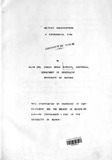| dc.description.abstract | Disciplinary problems among members of the Armed
Forces appear to be high (Glass et al., 1969; Atkinson, 1971
and Mirin, 1974). Over five years, (1968 - 1972) the U.S.
Army saw increase of 90% administrative discharges for
unfitness, unsuitability and misconduct (Nicholson et al.,
1974). The pattern of disciplinary problems in peace time
location include going away without official leave, (A.W.O.L.),
failure to attend to military duty, sloven attendance to
military duty, acts of aggression among peers and supervisors,
alcohol plus drug abuse and misapplication/misappropriation of
public property/funds, (Beary et al., 1983; Miller, 1984;
Fox, 1974 and Friedman, 1972). Psychiatric disorders have
been associated with disciplinary problems in the military
situation. These include neurosis, psychosis, personality
disorders and para-suicide (Ayugi, 1986; Mucha et al., 1970;
Tucker et al., 1967 and Offenkrantz et al., 1957). Attempts
at rehabilitation of the disciplinary maladju~ted soldier
are rather disappointing (Colman et al., 1969; Robbins, 1967).
This author studied disciplinary maladjustment, in Moi Air
Base over a one year period, (1986). Data was collected on
the type and nature of the disciplinary maladjustment. Personal,
service, peer group and family factors likely to contribute to
commission of military code infractions were evaluated. Among
the 75 offenders studied, 37% were charged with A.W.O.L., 20% were
charged with conduct to predudice of good discipline, 16% were charged
with failure to perform military duties, 14% were charged with
disobedience to standing orders, 7% were charged with quarrelling
and fighting, 3% were charged with neglect of duty and miscellaneous
offences relating to property each. Fifty-seven percent had a
previous offence in the previous three months.
Eighty-four percent of the offenders were privates, eight percent
were corporals, four percent were sergeants and the remainder four
percent were senior sergeants and above. Most (59%) were aged below
25 years with 97% being aged below 36 years. Majority (61%) were of
secondary school education and above. Minority (47%) were in "soft
jobs". Sixty-three percent had served the military for less than
6 years and 94% had served for less than 11 years. Most of them (48%)
blamed themselves for the offences committed with only 24% blaming
the military service. Seventy-five percent gave history of regular
use of alcohol and 51% of the alcohol drinkers were positive for
brief MAST, 77% had raised M.C.V. wher~as 30% had raised G.G.T. levels.
Sixty-nine percent smoked cigarettes, 16% chewed miraa and 20% had
tasted cannabis whereas 7% used tranquillisers, stimulants and
cocaine. Thirty-nine percent had a psychiatric diagnosis:- of
these 38% had neurotic depression, 24% personality disorders,
14% anxiety neurosis, 14% manic-depressive psychosis and the
remainder had temporal lobe epilepsy, psychosomatic disorder,
and drug induced psychosis; with a frequency of 3% each.
Majority (56%) were married and 64% were married for
less than nine years. Sixy-four percent had less than three
children whereas 79% were geographically separated:fromtheir
wives despite reported good marital harmony (69%). No
significant poor relations with extendea family members
were noted and there was no evidence of significant gen~tic
loading for psychiatric illness in the offenders. Peer
relationships were good (80%) while relationships with military
supervisors were equivocal.
It is hereby suggested that disciplinary maladjustment
is a major concern of the military commander at any level.
Any attempt to curb the problem is a-saving to the military
and a contribution towards the creation of a cadre military
force. Psychiatric evaluation of military offenders at the
earliest possible occasion is suggested as a step in the right
direction. This calls for the training of military medical
personnel conversant with the evaluation of human behaviour
at all levels. Psychiatrists well conversant with the nuances
of the military subculture should be used as personnel
officers/consultants for effective deployment of personnel
in the military, both in command and otherwise, to minimize the
"square-peg-in-a-round-hole" phenomenon with resultant
failure to adjust to military life. | en |
| dc.description.department | a
Department of Psychiatry, University of Nairobi, ; bDepartment of Mental Health, School of Medicine,
Moi University, Eldoret, Kenya | |

